.
14.08.2015 / 9.34 MESZ
Rosetta captures images of jet-blasting comet
Cameras of European Space Agency craft get within 330km of comet 67P as it hurtles past sun, rattles its ‘guest’, Philae, and spews out gas and boulders
Cameras on the Rosetta spacecraft captured powerful jets of steam and dust erupting from comet 67P as it tore past the sun on Thursday morning. Images beamed back from the probe showed the comet spewing material as it warmed up on its closest pass of the sun and began its journey back out into the frigid far reaches of the solar system.
.
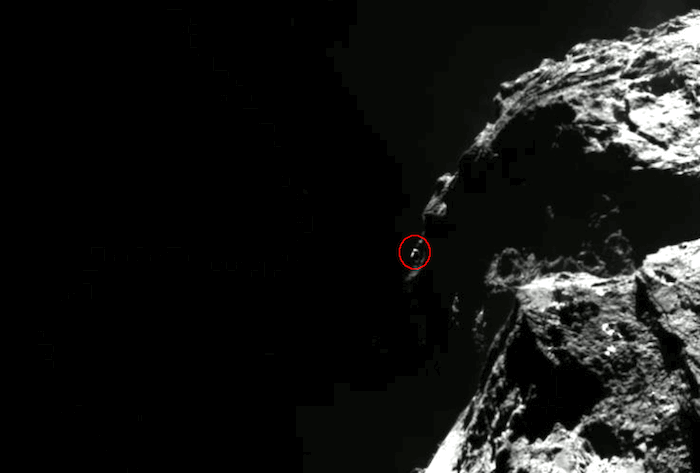
Pictures taken a few hours before the comet’s close encounter with the sun recorded one powerful outburst that flung a visible, bright, stream of dust and vapour several kilometres into space.
.
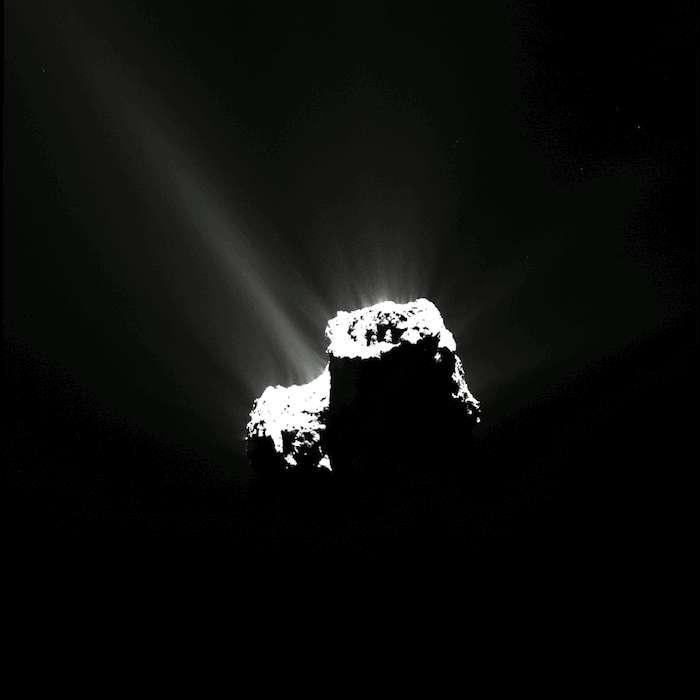
Holger Sierks, the lead scientist on Rosetta’s Osiris camera, compared the jet blasting from the spinning comet to a garden water sprinkler. “It’s the first time this has been seen in space,” he said.
When Rosetta, which was built and launched by the European Space Agency, arrived at the comet in August last year its surface temperature was a chilly -70C (-94F). But as the comet swung closer to the sun, its surface warmed. In May, the comet was a few degrees below 0C (32F). Over the next month, it could reach 30C.
The rise in temperature has transformed the comet from a dull and frozen lump into a body billowing furiously as it tumbles through space. The amount of water being shed from the comet has risen 1,000-fold in the past year. The comet now sheds 300kg of water every second, enough to fill an Olympic swimming pool every two-and-a-half hours. The vapour leaving the comet dislodges a tonne of dust every second.
Other images released by the Rosetta team on Thursday showed a boulder being blasted off the surface of the comet and out into space. Sierks said the boulder was spinning at five revolutions a second and going fast enough to leave the comet, which has a length of about 4km (2.4 miles) for good rather than go into orbit around it. Mission scientists are still calculating the size of the boulder, but said it was between four metres and 40 metres wide.
Much of the gas and debris dislodged from the surface forms the comet’s atmosphere or coma, or helps to build up its spectacular tail. Rosetta is too close to image the comet’s tail directly, but groundbased telescopes have measured it stretching out across 120,000km (74,564 miles).
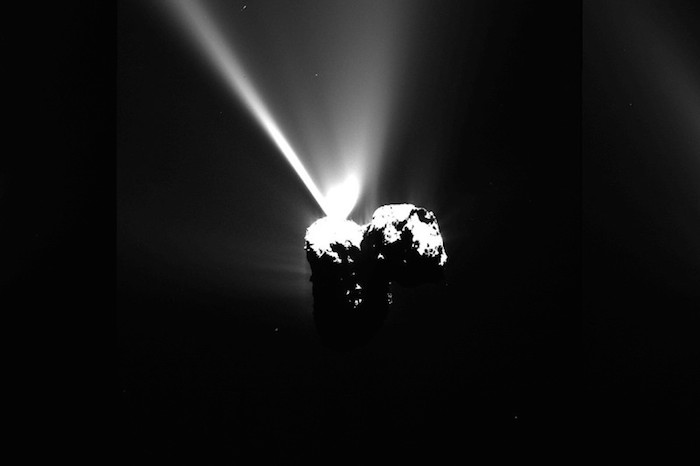
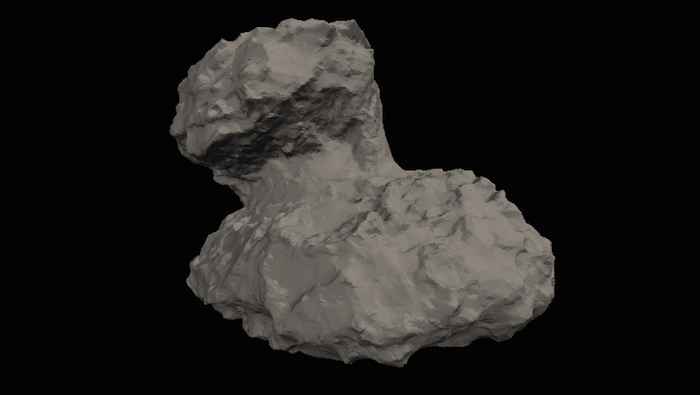
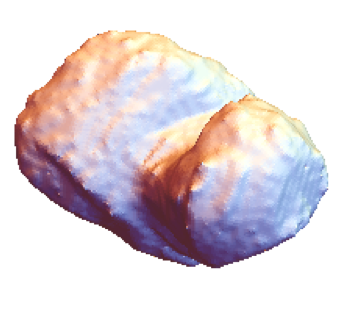
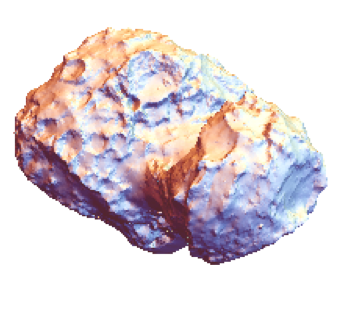
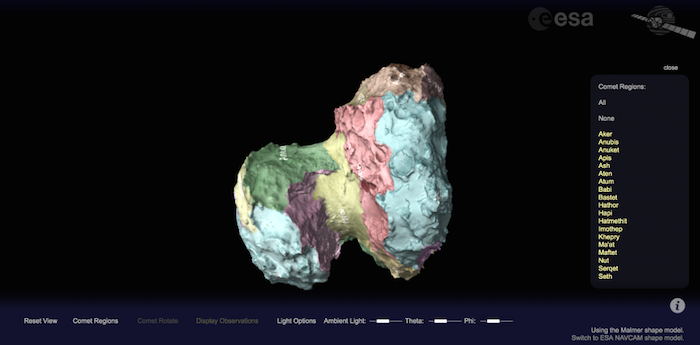

Rosetta orients itself by the stars and has had to back away from the comet to prevent its star trackers from being blinded by dust. The latest images were taken at about 330km away from the comet. At such a distance Rosetta’s cameras cannot see whether a 500-metre crack in the neck of the comet has widened. At some point the comet could break in two, but the chances of that happening while Rosetta is orbiting the comet were minuscule, said Sierks.
Down on the surface the conditions are becoming ever more violent for the little Philae lander, which, in November last year, became the first to touch down on a comet. The ESA lander has not been heard from in the past month, but scientists hope it may still make contact now that it is receiving more sunlight to charge its batteries and Rosetta has flown back up to the comet’s north where communcation links are easier.
Barbara Cozzoni, Philae operations engineer, said the powerful vapour jets were unlikely to knock Philae off the comet but might push it into a bad position where it could not call home. “There’s a danger that it might change the attitude of Philae,” she said. The team is now working on a way to send commands to Philae in the hope of getting fresh data back from the battered lander.
Rosetta will escort the comet out towards Jupiter until September 2016 when flight controllers will fly lower and lower around the comet until the spacecraft crash lands.
“I’d bet on a hardish landing,” said Armelle Hubault, spacecraft operations engineer. “There are boulders and mountain-sized rocks everywhere. It’s very likely the spacecraft will hit one of those and stumble at the end. So it will not be very graceful.”
.

Quelle: theguardian
.
Update: 22.45 MESZ
.
A SHAPE MODEL – WHAT’S THAT?
Today, a new shape model of Rosetta’s comet is released by ESA. Some of you might immediately know what this is and how you might use it, and others will wonder ‘what’s that?’ This blog post, which has been prepared with the help of experts from the Rosetta Flight Dynamics team, explains what a shape model is, how it is created, and what you could use it for.
.

The ESA NavCam shape model that is released today. Credit: ESA/Rosetta/NAVCAM, CC BY-SA IGO 3.0
.
At the most basic level, a shape model is a geometrical representation of an object. Shape models are commonly used in computer programmes where the motion or change of shape of a complex object needs to be represented. Applications can vary from medical imaging of organs, creating characters in cartoons and computer games, or — closer to home (at least for the Rosetta team) — modelling how the surface of a comet changes as it rotates.
Back in the summer of 2014, the Rosetta mission operations and flight dynamics teams were faced with the mammoth task of figuring out how to approach and navigate around Comet 67P/Churyumov-Gerasimenko. After a year of marvellous close-up views of this comet it’s easy to forget that early models of the comet bore very little resemblance to the reality.
The first hints that the comet might not have a simple shape came in July 2014, when images taken by the scientific camera, OSIRIS, revealed a double-lobed object. It was soon clear that navigation would be a challenge, and an important factor in successful navigation would be a robust shape model.
The first, crude shape models were constructed by the flight dynamics team, using a method called silhouette carving. For this, software is used to map the silhouette of the comet, as seen in NavCam images, onto a large ‘virtual’ body and the parts of the body that extend beyond the silhouette are removed. As more and more images of different regions, taken from different perspectives, are added, the shape of the comet starts to emerge.
.

This image shows an example of a crude shape model generated using the silhouette carving method. The colours are the default settings used in the software tool mathematica. This silhouette carving approach was the first step in creating a shape model that could eventually be used for navigating around 67P/C-G. Credit: ESA
.
The next step was to identify landmarks on the surface of the comet that could be used to create a framework of reference positions. For the first shape models, the team identified, by hand, 30 landmarks — easily recognisable features such as pits, valleys, or bumps — to make ‘maplets’. These maplets are small, 3D high-resolution maps. The first maplets covered 500 m x 500 m with 10 m resolution, while during closest approach to the comet the maplets covered 100 m x 100 m with 1 m resolution.
The maplets are generated by stereophotoclinometry, a technique that uses stereo images of regions of the surface and finds slopes by examining the way the surface looks under different illumination conditions. Once the slopes are known then the surface height can be inferred.
These maplets were then projected onto the crude shape model to provide a more detailed shape model. For recent shape models the team now use about 1000 landmarks, which are automatically identified from NAVCAM images.
.

This fine-detail shape model is an example of one generated using the stereophotoclinometry method. This method was also used to generate the ESA shape model that was released today. Credit: ESA
.
The ESA NAVCAM shape model is a core tool used by the team to precisely navigate around 67P/C-G. Each day, the positions of landmarks are identified in the most recent NAVCAM images and are provided to the orbit determination team who use this information to establish the position of the spacecraft with respect to the comet, and to plot the new trajectory. The orbit details are updated twice a week and are used by mission planners to devise the future orbits, and by the instrument scientists to plan their observations.
In addition to these operational aspects, a shape model is also an important tool for scientists analysing images and data from Rosetta. Such models can be used for calibrating data, studying changes on the surface, and for investigating the geology and morphology of the comet. The OSIRIS team have produced a number of shape models in the course of the past year which have been used by Rosetta scientists to select the landing site for Philae, and to determine physical properties of the comet, such as size, volume, and density, as well as measuring the rotation of the comet, its gravitational potential, and tracking changes on the surface.
And it’s not just people working directly on the mission who produce shape models. Mattias Malmer, an image processing expert and a space enthusiast, has developed a shape model based on publicly released NAVCAM images. This is accompanied by a ‘texture’ file that indicates the boundaries between the different geomorphological regions that scientists have identified on the comet.
Apart from the very specific operational or scientific applications that the Rosetta teams have for shape models, there are plenty of other uses for these models, such as printing your own 3D model of the comet or creating visualisation tools, such as the View Rosetta’s comet tool that is released today.
.
NEW: INTERACTIVE VIEWER FOR COMET 67P/C-G
In the week that we celebrate a year that Rosetta has been at Comet 67P/Churyumov-Gerasimenko and mark their passage through perihelion, we are delighted to present a new interactive tool that allows you to explore the shape and surface of this intriguing comet.
View Rosetta’s comet is based on images taken with Rosetta’s navigation camera, NAVCAM. Since November 2014, these images have been released under a Creative Commons license, which allows you to share them with whomever you like, to publish them on your blog or elsewhere, as well as to adapt, process, and modify them.
.

Screen shot from the View Rosetta's comet interactive tool.
As of 30 July this year, more than 6800 NAVCAM images are available to download from ESA’s Archive Image Browser, and that number will increase with the regular addition of many more as Rosetta's mission continues.
From reactions that we’ve had on this blog, via social media, and meeting people at events we know that many of you are intrigued and fascinated by Comet 67P/C-G — as we are.
As far back as August last year, when the unusual shape of this comet became clear, we saw the need for an interactive way of exploring the surface of the comet. More recently, we started to wonder about what could be done with the Rosetta images and 3D computer models of the shape of the comet.
A conversation that started on a Friday evening as a "Wouldn’t it be great if we had an interactive way to view the comet?" set our colleague Oliver Jennrich thinking, and by the following Monday morning he had come up with a simple prototype tool using a shape model that had been developed by Mattias Malmer an image processing expert and space enthusiast living in Sweden. Mattias used publicly available NAVCAM images to generate his model and then made it available via his own website.
With this basic tool, it was possible to zoom in and out, and rotate and pan across the comet. This was already better than anything we had in the Rosetta communications team, but as soon as we starting playing with it more ideas started to flow.
Could we add the geological regions that have been identified on the comet's surface? Could we tie this tool in with the huge repository of NAVCAM images in the Archive Image Browser? Could we include other shape models?
Over the next few weeks, Oliver implemented a number of new features, including a texture map made by Mattias to add the regions identified by Nicolas Thomas and colleagues in their scientific analysis of 67P/C-G.
Then Oliver added a trail of points along Rosetta’s trajectory to show where images of the comet have been taken by NAVCAM. That made it possible to link the tool to the NAVCAM database, to view and allow downloads of the corresponding images.
.

View Rosetta's comet interactive tool provides access to some of the best NAVCAM images in the ESA Archive Image Browser.
With subsequent support from João Martinho Moura and colleagues at Science Office, who also worked on our Where is Rosetta? tool, the code was optimised and the interface fine-tuned. Most recently, a separate ESA NAVCAM shape model, developed by the ESA Flight Dynamics team, was made available for release and has been added to the tool as an option.
You can find more detailed information about the tool here. (Note that the viewer does require a WebGL-enabled browser and graphics card.)
But this is just the beginning! It’s clear to us that there is a lot of scope to develop the tool further, but we want to make this ‘beta’ version available to you now, at the time of perihelion, to enjoy and try out.
We aim to make further releases ourselves, but the code is available as open source, so feel free to take it and develop it further — we hope you do!
Share with us your comments about your experience, including your possible enhancements of the viewer, or new ways that you have found to use the images and shape models, via the comments block below.
Stay tuned for more NAVCAM images and updates to this tool.
And don’t forget to join us later today, at 15:00 CEST, for a Google Hangout with Rosetta mission experts as we celebrate perihelion.
Quelle: ESA
4191 Views
